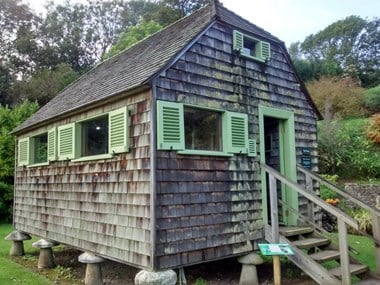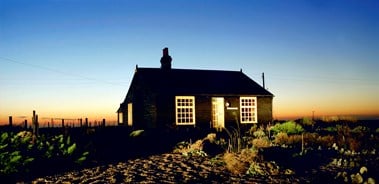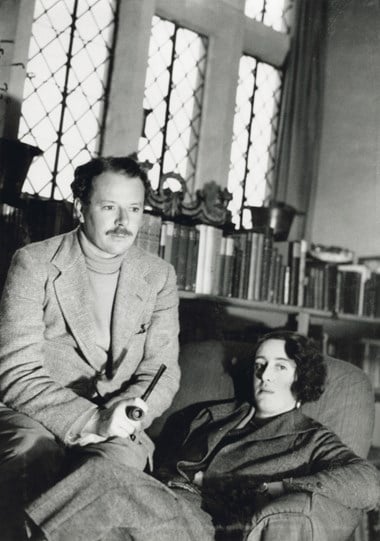Domestic Privacy
Homes offered LGBTQ people privacy away from family and neighbours, and potentially dangerous attacks from the authorities and disapproving members of the public. Some Queer people have used their homes creatively to protect their privacy and safety.
Smallhythe and Priest's House
Private homes have provided space for different types of Queer relationships. Edith (Edy) Craig, daughter of Victorian actress Ellen Terry, lived at Priest’s House in a lesbian ménage a trois. The building was situated in the grounds of Terry’s home, Smallhythe Place, in Kent. Craig, a suffragist and theatre director, had shared a home with writer and translator Christopher St John (Christabel Marshall) since 1899.
In 1916 the artist Tony (Clare) Atwood joined the household in Smallhythe and 31 Bedford Street, London. This was on Edy’s condition that: ‘If Chris does not like your being here, and feels you are interfering with our friendship, out you go!’ They lived together for the rest of their lives.
This domestic setup was very successful. The Smallhythe trio was visited by Queer artists and writers, including Virginia Woolf and Radclyffe Hall.
Edy Craig and her friends set up the Barn Theatre at Smallhythe, and held an annual drama festival from 1929. This attracted lectures and performances from many luminaries of the theatre world, including the Queer actor John Gielgud.
Sissinghurst
Poet and novelist Vita Sackville-West also visited Craig, St John and Atwood at Priest’s House. Sackville-West lived at Sissinghurst Castle, also in Kent, from 1932 with her husband Harold Nicolson. Both Sackville-West and Nicolson had numerous same-sex affairs.
Vita Sackville-West had a strong attachment to Sissinghurst, originally an Elizabethan country house. Derelict when she bought it, she restored the tower - where she had her study - and several other parts of the site. Around and between these buildings, Vita and Harold built their famous gardens.
Vita Sackville-West briefly left her husband for Violet Trefusis during their affair in 1918-21. Her diaries, which gave an account of this relationship, were discovered locked in a bag in her tower study after her death, and were published as Portrait of a Marriage (1973).
The most well known of Vita’s love affairs was that with the novelist Virginia Woolf. Woolf modelled her very successful book Orlando (1928) and its gender-shifting hero on her lover. Both Vita and Harold were discreet about their same-sex affairs. Their home at Sissinghurst allowed them to share a happy, Queer marriage.
Private Queer spaces
Architects John Seely and Paul Paget, designers of the Art Deco additions to Eltham Palace, were business as well as personal partners. They spent weekends at ‘The Shack’, a separate out building in the grounds of Mottistone Manor on the Isle of Wight. The couple could entertain guests at the Manor and then spend the night at ‘The Shack’, a safe space to avoid being suspected of a sexual relationship.
St Ann’s Court, a modernist house in Surrey, was designed (1936-37) by Gerald Schlesinger and architect Christopher Tunnard in direct response to contemporary homophobia. If they expected visitors, their double bed in the master bedroom could be separated into two halves. Separated by retractable screens, this now formed two single bedrooms. For more about St Ann's Court, see our LGBTQ Architecture section.
Other homes similarly obscured their owners’ intimate lives. Playwright Joe Orton and his partner Kenneth Halliwell’s flat at 25 Noel Road, Islington was to outsiders only the eclectic home of two ‘artistic’ ‘bachelors’. Two single beds separated across the expanse of the one bedroom in the flat supposedly maintained the fiction that the men were not Queer in interviews and press photo shoots.
Coming out at home
When the Sexual Offences Act (1967) decriminalised consensual homosexual sex between adult men in private, some men felt an enormous burden had been lifted. They might now live openly and publicly as homosexuals with partners and homes, like their neighbours.
Teacher Rex Batten and his partner moved to working-class East Dulwich in south east London in 1957. They bought a home together and felt it a safer location than the bedsits they’d previously lived in. With partial decriminalisation in 1967 they felt still safer and publicly bought a double bed. It was delivered to the door in front of the neighbours. ‘That was a hell of statement to make!’ Rex remembered.
Domestic Privacy Photo Gallery
Please click on the gallery images to enlarge.









